|
The first photograph I ever saw of maverick writer-director Sam Fuller pictured him with a cigar in one hand and an upward pointed automatic pistol in the other (you can see that image here). He wasn't acting or indulging in violent recreation, but directing. Word has it that instead of shouting "Action" he would fire the pistol skyward. It's the sort of seemingly apocryphal story that cult legends are built on, but in Fuller's case it was almost definitely true. Fuller was a genuinely larger than life character who lived up to the image most seem to have of him, and I'm talking from first hand experience here.
A good many years ago, I had the very real pleasure of attending an interview with Fuller at the National Film Theatre (now the BFI Southbank) to mark the release of his autobiographical 1980 war film The Big Red One. It's a fascinating experience to look back on, for at this time the cult that now surrounds Fuller and his remarkable body of work was barely large enough to qualify as a cult at all, and the interview itself was so poorly attended that those of us not seated right at the front were encouraged to move forward so that the venue would feel a little less empty. Just a few years later the combined praise of directors such as Martin Scorsese, Jim Jarmush and Quentin Tarantino prompted a major rediscovery and critical re-evaluation of Fuller's cinema, and the same event would doubtless have filled this sizeable venue three times over.
One of the things I'll always remember about it was Fuller's entrance. There was none of the careful stage management I'd witnessed at other such interviews – following a screening of the opening scene from The Big Red One, the lights went up to reveal Fuller, dressed in a loud shirt and – if I remember correctly – holding his trademark cigar, standing halfway down the central aisle and shouting back at those who had directed him towards the stage, "Where do I go? Down here?" He answered questions directly, entertainingly and without a hint of pretension, and seemed completely unfazed by the small size of his audience. Asked what his idea of a good crew was he replied "I tell them what I want, I go off, and when I come back it's done!" Later he listened patiently to an interminably long question from the audience, one whose tied-knot complexity bordered on gibberish, then turned to his host and cried in exasperation, "What did he just say? I didn't understand what he said!" How could you not love this man?
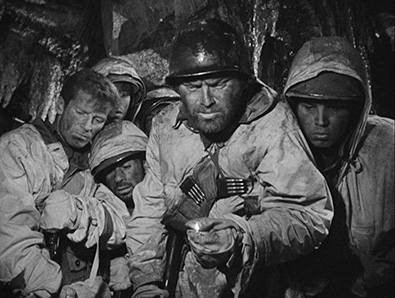
I'd be willing to bet that Fixed Bayonets! was one of the films on which that pistol was fired to get the actors moving. It's exactly the sort of work that helped secure Fuller's reputation as a director of tough, well-told action movies whose technical handling and attention to detail and character lifted them way above their sometimes B-movie production values. And if you're in the market for evidence of Fuller's influence on Scorsese and his contemporaries, then look no further. I'll get to that in a minute. Fuller's stamp here is on a lot more that the camera movements and editing.
Fixed Bayonets! kicks off with a textual salute to the US Infantry that sets the story in 1951 Korea, then switches to live action to blow a jeep full of American infantrymen off the road and introduce us to a tent full of officers with a difficult decision to make. Their division is facing certain defeat if they don't retreat, but actually doing so is not so simple. If the enemy get wind that they are on the move then they are likely to attack in force, which would almost definitely result in heavy US casualties. The commander decides they must leave one company of just 48 men as a rear guard, their job being to convince the opposing forces that the entire division is still dug in and ready to do battle, while the majority make their way quietly to safety. One of those charged to remain, reluctant corporal Denno (Richard Basehart), has a deep rooted fear of command, but as those who outrank him begin falling victim to enemy fire, the possibility looms that he may have to take charge of the company.
This may read like the setup for a by-the-numbers story of finding your inner hero in time of war, but even in that short synopsis above there are a couple of things that do not play by the contemporary war movie manual. For a start, there's an up-front acknowledgement that things did not always go well for US troops in this particular conflict, that sometimes they were outgunned and outmanoeuvred and that standing and fighting to the death was not the logical option. This willingness to face facts rather than bury them behind false heroics (Fuller himself – a decorated WW2 veteran – claimed that the only glory in war is survival) became a familiar ingredient of post-Vietnam war movies, but it's important to remember that Fixed Bayonets! was made and released in 1951, when American troops were still fighting in Korea and suffering sometimes significant losses and defeats. And while the enemy forces are regularly referred to as either 'Reds' or 'Commies', this is down-to-earth soldier speak rather than right-wing sermonising – the enemy soldiers are never caricatured or demonised, but instead shown as a relentless but professional and potentially deadly force to be reckoned with.
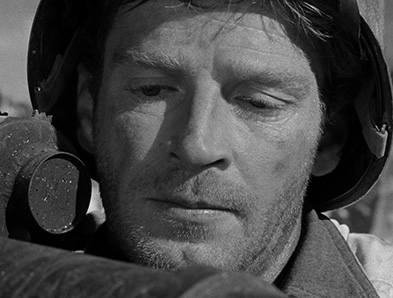
Although the main narrative arc revolves around Denno, he is just one soldier in a distinctly drawn ensemble group that includes characters who would go on to become genre staples in the years to come. The agitated Italians, the cheerfully pragmatic old hand Sgt. Rock (a splendid Gene Evans) and the dryly amusing intellectual Whitey (Skip Homeier) would sit just as comfortably in Fuller's 1980 The Big Red One, but just how many war movie platoons can you think of that include a Native American? A pleasingly varied and likeable bunch, the soldiers' breezy interaction is one of the film's real pleasures and one that gives it an unexpected contemporary edge. This is echoed in Fuller's direction, which takes advantage of the single snowbound studio set to repeatedly get Lucien Ballard's crane-mounted camera on the move, covering entire sequences in single, highly mobile and sometimes complex shots that are never designed to draw attention to themselves.* Elsewhere Ballard's camera placement and Nick DeMaggio's editing combine to sometimes nail-biting effect, notably in the brilliantly staged sequence in which Denno has to cross an ice-covered mine field to reach a wounded superior, an object lesson in how to grind an audience into its seats. The use of facial close-ups to connect us with the emotions and humanity of the platoon members is also effective – the early sequence in which the rear guard soldiers watch silently as their comrades slowly make their retreat is for my money up there with the emotive final scene of Kubrick's Paths of Glory, which Fuller's film predates by six years. The film even anticipates some of the genre's later visual ticks, with white flash frames used to emphasise artillery fire and the camera shaken by the impact of the shell blasts. That both effects were created in post-production is neither here nor there.
Fuller allows us to engage with the individual soldiers from an early stage by defining them quickly and clearly and giving them interesting things to say and do, and with the plight of the company as a whole by focussing on the basics of survival rather than the politics of this particular war, which the universality of the story renders largely irrelevant. His no-nonsense approach to the violence of warfare is sometimes startling, with ferocious fire-fights kicking off without warning and explosions triggered so close to the actors that I'd be amazed if there weren't on-set injuries as a result. That Denno's boy-to-man journey follows the expected path does no harm to a film in which the action is so breathlessly staged and the quieter moments of human interaction are so well written and richly textured. The intermittent vocalisation of Denno's thought processes may feel a tad unnecessary, but this is later expanded to include the musings of all of the surviving company members, a nicely handled drift from man to man that is unexpectedly capped by a moment of left-field comedy.
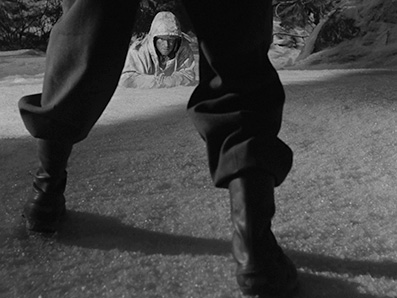
Widely recognised as one of the essential works of a man who was once one of American cinema's most undervalued artists (in Xan Cassavetes' excellent documentary Z Channel: A Magnificent Obsession, it's one of the two Sam Fuller films that Quentin Tarantino ties himself up in knots of frustration at the memory of not being able to see when they were transmitted), Fixed Bayonets! thoroughly deserves both its high reputation and the exclamation mark in its title. Its combat is realistic and hard-hitting, its characters engaging and its grip unwavering, while the dialogue and performances manage a neat balancing act between naturalism and stylised smart. There are a fair few equally qualified candidates, but if you're looking for a film that defines just why Sam Fuller is held in such high esteem by modern filmmakers and film enthusiasts alike, then Fixed Bayonets! should be high up on your shortlist.
By the way, the private who says "I think I hear them coming" about two minutes from the end is played by an uncredited (and unrecognisable) young actor named James Dean.
Back in 2007 when I reviewed the Optimum DVD release of the film I was impressed with the transfer, particularly the nicely pitched contrast and picture crispness, which really brought the monochrome image to life. What went for that SD transfer goes double for the Twentieth Century Fox 4K restoration that was the basis for the HD transfer on the Blu-ray in this Masters of Cinema dual format release. Lucien Ballard's monochrome cinematography is handsomely served here, having a lovely tonal range and boasting a markedly higher level of detail than you'll find anywhere on the DVD – writing that was a blur on the map in the opening scenes is clearly legible here, and at one point it struck me that I could see not only the texture of the metal on one of the soldier's helmets, but also every nick and bump of wear and tear. As you would expect, the picture is virtually spotless and displays no untoward movement within the 1.37:1 frame. Film grain is clearly visible, but does not feel artifically enhanced.
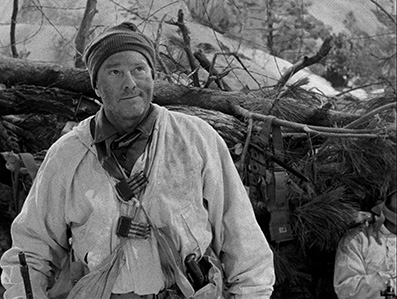
The Linear PCM 2.0 mono soundtrack is also in fine shape, the expected age-imposed range restrictions (little bass, slight treble bias) still allowing for clear reproduction of dialogue and some hefty volume jumps for explosions that never distort.
Optional English subtitles for the deaf and hearing impaired are available.
One area in which the Optimum DVD was seriously lacking was extra features – quite simply, there were none. There are four in this release, and two of them are crackers.
The chief attraction here is a commentary by Australian writer and critic Adrian Martin, a man who is fast becoming one of my favourite contributors to Masters of Cinema Blu-ray and DVD releases. Clearly a fan of the film and of Fuller's work in general, his commentary here is loaded to the gills with smart observations, thoughtful analysis and intriguing deconstruction of some of the film's key components, which is backed by a string of quotes from Fuller himself and a number of interested others. Even as someone who has seen the film a number of times and counts himself a long-standing member of the Sam Fuller fan club, I never felt like Martin was recycling information I'd already processed, and his acute observations and clearly detailed research really did expand my appreciation of the film. He even explores some of the more negative responses to the film and Fuller's direction, notably a review by British critic Gavin Millar, whose hostile dismissal of the film on its release feels downright bemusing in light of its cinematic vigour and subsequent influence. A superb extra feature and an essential companion to the film.
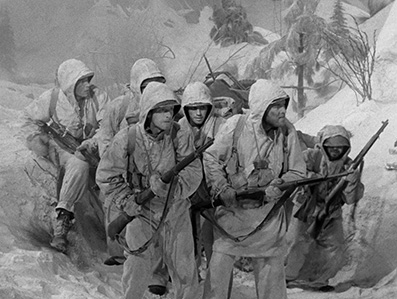
The Theatrical Trailer (2:32) plays up the very sort of heroic patriotism that the film eschews and that Fuller himself despised in war movies.
Also on the disc is an Image Gallery, featuring a number of high resolution production and press photos, which you cycle through manually using the remote control.
Finally we have the expected and handsomely produced Masters of Cinema Booklet, which kicks off with an excellent essay on the film and its genesis by Glenn Kenny. This is followed by Fuller's own recollections of its making and of its immediate (and similarly Korean War themed) predecessor, The Steel Helmet, all of which is taken from his hugely entertaining autobiography, The Third Face. This is a particularly welcome inclusion given how hard it is to get your hands on that book at the moment, though read this and you'll likely be willing to sell one of your close relatives to get hold of a copy. Credits, notes on viewing and stills are also included.
As a Fuller devotee and a long-standing fan of Fixed Bayonets!, I was excited by the news of its restoration and UK Blu-ray release, but to have it accompanied by such an informative commentary and such a well assembled and enjoyable booklet puts a delicious layer of the tastiest icing on an already very satisfying cake. Wholeheartedly recommended.
* I have no doubt that Fuller saw this as a purely practical move to save time. When asked about the possible surrealist influence on the shot of the statue of Christ with ants crawling over its face in the opening sequence of The Big Red One at the above mentioned NFT interview, he replied, "There were ants on it when we got there and it looked interesting so we filmed it."
|